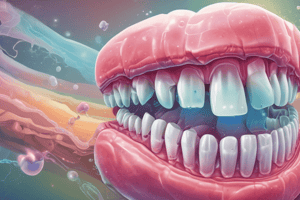Podcast
Questions and Answers
What is a crucial aspect of a dentist's understanding of oral materials, and why is it important?
What is a crucial aspect of a dentist's understanding of oral materials, and why is it important?
Understanding how materials interact with oral tissues, saliva, and other factors in the oral environment, to ensure their efficacy and biocompatibility.
What role does biochemistry play in understanding oral microorganisms, and why is this knowledge essential?
What role does biochemistry play in understanding oral microorganisms, and why is this knowledge essential?
Biochemistry helps understand the biochemical processes of oral microorganisms, and their role in oral health and disease, which is essential for diagnosing and treating conditions like dental caries and periodontal diseases.
What are the biochemical components of saliva that are crucial for maintaining oral health?
What are the biochemical components of saliva that are crucial for maintaining oral health?
Buffering capacity, antimicrobial properties, and demineralization capabilities.
How does biochemistry contribute to the development of treatments for dental caries and erosion?
How does biochemistry contribute to the development of treatments for dental caries and erosion?
What biochemical factors contribute to the initiation and progression of periodontal disease?
What biochemical factors contribute to the initiation and progression of periodontal disease?
Why is it essential for dentists to have a deep understanding of saliva composition and function?
Why is it essential for dentists to have a deep understanding of saliva composition and function?
What type of biomarkers are associated with periodontal health and disease?
What type of biomarkers are associated with periodontal health and disease?
What is the purpose of salivary biomarker analysis in dentistry?
What is the purpose of salivary biomarker analysis in dentistry?
What are some examples of biomarkers associated with dental caries?
What are some examples of biomarkers associated with dental caries?
What type of biomarkers are associated with oral cancer?
What type of biomarkers are associated with oral cancer?
What can be measured in saliva to provide valuable insights into periodontal inflammation and tissue destruction?
What can be measured in saliva to provide valuable insights into periodontal inflammation and tissue destruction?
What is the significance of measuring biomarkers in gingival crevicular fluid or saliva in periodontal disease?
What is the significance of measuring biomarkers in gingival crevicular fluid or saliva in periodontal disease?
What is the main difference between integral and peripheral proteins in terms of their interaction with the lipid bilayer?
What is the main difference between integral and peripheral proteins in terms of their interaction with the lipid bilayer?
What is the function of carbohydrate moieties in glycoproteins and glycolipids in cell membranes?
What is the function of carbohydrate moieties in glycoproteins and glycolipids in cell membranes?
What is the role of integral proteins in dentistry?
What is the role of integral proteins in dentistry?
What is the main function of peripheral proteins in cells?
What is the main function of peripheral proteins in cells?
What is the characteristic of integral proteins that allows them to anchor in the lipid bilayer?
What is the characteristic of integral proteins that allows them to anchor in the lipid bilayer?
What is the role of peripheral proteins in dental tissue repair and inflammation?
What is the role of peripheral proteins in dental tissue repair and inflammation?
What is the role of receptors for inflammatory mediators in oral epithelial cells, fibroblasts, and immune cells?
What is the role of receptors for inflammatory mediators in oral epithelial cells, fibroblasts, and immune cells?
How do cytokine receptors on gingival fibroblasts and immune cells influence the progression of periodontal disease?
How do cytokine receptors on gingival fibroblasts and immune cells influence the progression of periodontal disease?
What is the role of growth factor receptors in wound healing and tissue repair in oral tissues?
What is the role of growth factor receptors in wound healing and tissue repair in oral tissues?
What type of receptors are involved in the regulation of dental pulp function and homeostasis?
What type of receptors are involved in the regulation of dental pulp function and homeostasis?
What is the outcome of glycoprotein receptors interacting with inflammatory mediators in the oral cavity?
What is the outcome of glycoprotein receptors interacting with inflammatory mediators in the oral cavity?
What is the role of membrane glycoproteins in oral tissues following dental procedures or trauma?
What is the role of membrane glycoproteins in oral tissues following dental procedures or trauma?
What is the role of mitochondria in oral tissues, and how do dysfunctional mitochondria contribute to oral diseases?
What is the role of mitochondria in oral tissues, and how do dysfunctional mitochondria contribute to oral diseases?
What is the function of the Golgi apparatus in oral tissues, and how does it contribute to enamel formation and dentinogenesis?
What is the function of the Golgi apparatus in oral tissues, and how does it contribute to enamel formation and dentinogenesis?
What role does the endoplasmic reticulum (ER) play in protein synthesis and modification in oral tissues?
What role does the endoplasmic reticulum (ER) play in protein synthesis and modification in oral tissues?
How does the Golgi apparatus contribute to saliva production and secretion?
How does the Golgi apparatus contribute to saliva production and secretion?
What is the significance of understanding the function of the Golgi apparatus in dental cells and tissues?
What is the significance of understanding the function of the Golgi apparatus in dental cells and tissues?
What is the relationship between the Golgi apparatus and the endoplasmic reticulum (ER) in oral tissues?
What is the relationship between the Golgi apparatus and the endoplasmic reticulum (ER) in oral tissues?
Flashcards are hidden until you start studying




